Walter Elias Disney
Chicago December 5, 1901 – December 15,
1966 Los Angeles
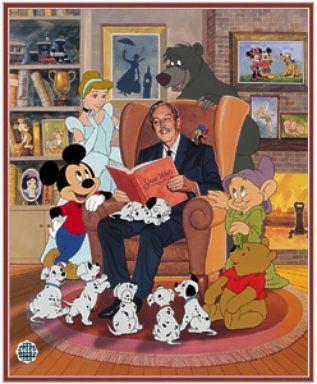
Walter
Elias Disney was an American film producer, director, screenwriter, voice actor,
animator, and philanthropist. He was the son of parents Flora and Elias Disney,
and had three brothers and one sister. As the co-founder (with his brother Roy
O. Disney) of Walt Disney Productions, Walt became one of the most well-known
motion picture producers in the world. The corporation he co-founded, now known
as The Walt Disney Company, today has annual revenues of approximately US $30
billion.
Walt Disney is particularly noted
for being a hands-on film producer, and a popular showman, as well as an
innovator in animation and theme park design. Walt Disney and his staff received
more than 950 honors from every nation in the world throughout his career. He
was nominated for 48 Academy awards and 7 emmys, holding the record for most
Oscar nominations. His brother Roy helped him tremendously with his work. He
also had two daughters, Diane and Sharon. He and his staff created a number of
the world's most popular animated properties, including the one many consider
Disney's alter ego, Mickey Mouse. He is also well-known as the namesake of the
Disneyland and Walt Disney World Resort theme parks in the United States.
Walt Disney died of lung cancer
on December 15, 1966, a few years prior to the opening of his Walt Disney World
dream project in Orlando, Florida.
1906-1937: The beginnings
Chicago

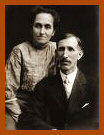 Walt Disney's ancestors emigrated from
Gowran, County Kilkenny in Ireland. Disney was born in Chicago.
Walt Disney's ancestors emigrated from
Gowran, County Kilkenny in Ireland. Disney was born in Chicago.
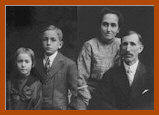 His father Elias
Disney had moved to the United States after his parents failed at farming in
Canada. As a child Elias moved with his family all around the United States, as
his father chased various business ventures. He also worked as a mailman in
Kissimmee (Orlando), Florida, future home of Walt Disney World. Elias moved to
Chicago in the late 1800s soon after his marriage to Flora Call.
His father Elias
Disney had moved to the United States after his parents failed at farming in
Canada. As a child Elias moved with his family all around the United States, as
his father chased various business ventures. He also worked as a mailman in
Kissimmee (Orlando), Florida, future home of Walt Disney World. Elias moved to
Chicago in the late 1800s soon after his marriage to Flora Call.
While in Marceline, Disney
developed his love for drawing. One of their neighbors, a retired doctor named
"Doc" Sherwood, paid him to draw pictures of Sherwood's horse, Rupert. He also
developed his love for trains in Marceline. He would put his ear to the tracks
in anticipation of the coming train. He would look for his uncle, engineer
Michael Martin, running the train.
Kansas City
In 1909, Elias Disney suddenly
came down with typhoid fever and was unable to work the farm, even with his
older sons helping him. He sold the farm and lived in a rented house until 1910,
when they moved to Kansas City.
When the family arrived in Kansas
City, Elias Disney purchased a newspaper route for the Kansas City Star. Since
Walt's older brothers Herbert and Raymond had left home, he had Walt and Roy
help with the route. Working on the paper route required waking up at 3:00 in
the morning every day. Disney later recalled that they would deliver the paper
in the heat of summer and during the dead of winter.
According to the Kansas City
Public School District records, Disney began attending the Benton Grammar School
in 1910, and graduated on June 8, 1911, being held back a year so that Ruth
could go with him. In 1915 Disney enrolled in weekend classes at the Kansas City
Art Institute. Because of his early-morning paper runs, he had trouble
concentrating and fell asleep in class often. He was also prone to daydreaming
and he would rather doodle in class.
Chicago
Disney as an ambulance driver during the war.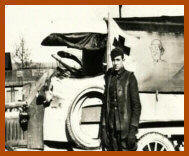
In 1917 Disney began his freshman
year at McKinley High School in Chicago and began taking night courses at the
Chicago Art Institute. Disney was the cartoonist for the school newspaper. His
cartoons were very patriotic, focusing on World War I. Disney dropped out of
high school at 16 so he could join the Army. But the army didn't take him
because he was too young to enlist.
Instead, Walt and one of his
friends decided to join the Red Cross. They were supposed to be 17, but Walt was
only 16 at the time. Against his father's will, his mother forged his birth
certificate so it said Walt was born in 1900 instead of 1901. The Red Cross sent
him to France for a year. During that year, he drove an ambulance covered from
top to bottom with his imaginitive Disney Characters.
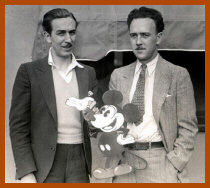 He moved into Kansas City to
begin his artistic career. His brother Roy worked at a bank in the area and got
a job for him through a friend at the Pesemen-Rubin Art Studio. At Pesmen-Rubin,
Disney made ads for newspapers, magazines, and movie theatres. It was also there
that he met a shy cartoonist named Ubbe Iwerks. The two respected each other's
work so much, they became fast friends and decided to start their own art
business.
He moved into Kansas City to
begin his artistic career. His brother Roy worked at a bank in the area and got
a job for him through a friend at the Pesemen-Rubin Art Studio. At Pesmen-Rubin,
Disney made ads for newspapers, magazines, and movie theatres. It was also there
that he met a shy cartoonist named Ubbe Iwerks. The two respected each other's
work so much, they became fast friends and decided to start their own art
business.
Disney and Iwerks (who now
shortened his name to Ub Iwerks) formed a company called "Iwerks-Disney
Commercial Artists" in January 1920 (it was originally called Disney-Iwerks, but
the two thought they would be confused with a shop that made eyeglasses).
Unfortunately, few clients were willing to hire the inexperienced duo. Iwerks
left temporarily to earn money at Kansas City Film Ad. Disney followed suit
after the business venture went nowhere and collapsed.
Kansas City Film Ad
At Kansas City Film Ad, Disney
and Iwerks worked on primitive animated advertisements for local movie houses.
Disney was fascinated by the possibilities inherent in animation. He spent many
days at the Kansas City Public Library reading over books on anatomy and
mechanics. He also read a book by Edweard Muybridge about animation. He used his
time at Film Ad wisely, experimenting with animation and film techniques. He
even borrowed one of the film cameras and experimented at home.
After two years' experience at
Film Ad, Disney felt he had enough experience to start another business venture.
Laugh-O-Gram Films
In 1922, he started a small
company called Laugh-O-Grams which began by selling short animated films to
local companies in Kansas City. By the time Walt had started to create The Alice
Comedies, the company went bankrupt. Even though the company ended, Walt did not
give up, he packed up what he had of his Alice Comedies and decided to move to
Hollywood to try and start a new business.
Hollywood
When Disney arrived in Los
Angeles, he had $40 in his pocket and an unfinished cartoon in his suitcase.
Interestingly, he first wanted to break away from animation, thinking he could
not compete with the studios in New York City. Disney said that his first
ambition was to be a film director. He went to every studio in town looking for
directing work; they all promptly turned him down.
Because of the lack of success in
live-action film, Disney turned back to animation. His first Hollywood cartoon
studio was a garage in his uncle Robert's house. Disney sent an unfinished print
to New York distributor Margaret Winkler, who promptly wrote back to him. She
wanted a distribution deal with Disney for more live-action/animated shorts
based upon Alice's Wonderland.
Disney looked up his brother Roy,
who was recovering from tuberculosis in a Los Angeles veteran's hospital. Disney
pleaded with his brother to help him with his fledgling studio, saying that he
could not keep his finances straight without him. Roy agreed and left the
hospital with his brother. He never went back and never had a recurrence of
tuberculosis. Virginia Davis (the live-action star of Alice’s Wonderland)
and her family were relocated at Disney's request from Kansas City to Hollywood,
as were Iwerks and his family. This was the beginning of the Disney Brothers'
Studio.
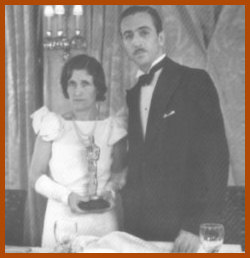 In 1925, Disney hired a young
woman named
Lillian Bounds to ink and paint celluloid. He was immediately taken with
her. She began to pull double duty as secretary a few months later. Disney then
began to take her out on dates, their first being the
Broadway show,
No, No, Nanette. He would also take her out on drives in the hills of
Los Angeles. On one drive, he asked her if he should buy a new car or a ring
for her finger. They were married on July 15, 1925. She later jokingly commented
that he was disappointed that she did not tell him to buy the car. They
honeymooned at
Mount Rainier.
In 1925, Disney hired a young
woman named
Lillian Bounds to ink and paint celluloid. He was immediately taken with
her. She began to pull double duty as secretary a few months later. Disney then
began to take her out on dates, their first being the
Broadway show,
No, No, Nanette. He would also take her out on drives in the hills of
Los Angeles. On one drive, he asked her if he should buy a new car or a ring
for her finger. They were married on July 15, 1925. She later jokingly commented
that he was disappointed that she did not tell him to buy the car. They
honeymooned at
Mount Rainier.
Alice Comedies
The new series, "Alice
Comedies," was reasonably successful, and featured both
Dawn O'Day and Margie Gay as Alice after Virginia
Davis’ parents pulled her out of the series because of a pay cut. Lois Hardwick
also briefly assumed the role. By the time the series ended in 1927, the focus
was more on the animated characters, in particular a cat named Julius who
recalled
Felix the Cat, rather than the live-action Alice.
Oswald the Lucky Rabbit
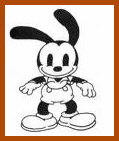 By 1927,
Charles B. Mintz had married Margaret Winkler and assumed control of her
business, and ordered a new all-animated series to be put into production for
distribution through
Universal Pictures. The new series, "Oswald
the Lucky Rabbit", was an almost instant success, and the Oswald character,
first drawn and created by Iwerks, became a popular property. The Disney studio
expanded, and Walt hired back Harman, Ising, Maxwell, and Freleng from Kansas
City.
By 1927,
Charles B. Mintz had married Margaret Winkler and assumed control of her
business, and ordered a new all-animated series to be put into production for
distribution through
Universal Pictures. The new series, "Oswald
the Lucky Rabbit", was an almost instant success, and the Oswald character,
first drawn and created by Iwerks, became a popular property. The Disney studio
expanded, and Walt hired back Harman, Ising, Maxwell, and Freleng from Kansas
City.
In February of 1928, Disney went
to
New York to negotiate a higher fee per short from Mintz. Disney was shocked
when Mintz announced that not only did he want to reduce the fee he paid Disney
per short, but that he had most of his main animators, including Harman, Ising,
Maxwell, and Freleng (notably excepting Iwerks) under contract and would start
his own studio if Disney did not accept the reduced production budgets.
Universal, not Disney, owned the Oswald trademark, and could make the films
without Disney.
Disney declined Mintz's offer and
lost most of his animation staff. The defectors became the nucleus of the Winkler Studio, run by Mintz and his
brother-in-law George Winkler. When that studio went
under after Universal assigned production of the Oswald shorts to an in-house
division run by
Walter Lantz, Mintz focused his attentions on the studio making the "Krazy
Kat" shorts, which later became
Screen Gems, and Harman, Ising, Maxwell, and Freleng marketed an Oswald-like
character named
Bosko to
Leon Schlesinger and
Warner Bros., and began work on the first entries in the
Looney Tunes series.
It took Disney's company 78 years
to get back the rights to the Oswald character. In a move that sent sports
broadcaster
Al Michaels to
NBC Sports for their Sunday night
NFL coverage, the
Walt Disney Company reacquired the rights to Oswald the Lucky Rabbit from
NBC Universal in 2006.
Mickey Mouse
The title card of
Steamboat Willie credits both Walt Disney and Ub Iwerks
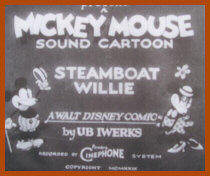
After having lost the rights to
Oswald, Disney had to develop a new "star". Most Disney biographies state that
Disney came up with a mouse character on his trip back from New York. It is
debated whether it was he, or Iwerks who actually designed the mouse (which
basically looked like Oswald, but with round instead of long ears). The first
films were animated by Iwerks, his name was prominently featured on the title
cards. The mouse was originally named "Mortimer", but later christened "Mickey
Mouse" by Lillian Disney.
Mickey's first animated short
produced was
Plane Crazy, which was, like all of Disney's previous works, a
silent film. After failing to find distributor interest in
Plane Crazy or its follow-up,
The Gallopin' Gaucho, Disney created a Mickey cartoon with
sound called
Steamboat Willie. A businessman named
Pat Powers provided Disney with both distribution and
Cinephone, a sound-synchronization
process. Steamboat Willie became a success, and Plane Crazy,
The Galloping Gaucho, and all future Mickey cartoons were released with
soundtracks. Disney himself provided the vocal effects for the earliest cartoons
and performed as the
voice of Mickey Mouse until 1937. Disney believed Mickey would make it far
into television.
Silly Symphonies
Joining the Mickey Mouse series
in 1929 were a series of musical shorts called
Silly Symphonies. The first of these was entitled
The Skeleton Dance and was entirely drawn and animated by Iwerks, who
was also responsible for drawing the majority of cartoons released by Disney in
1928 and 1929. Although both series were successful, the Disney studio was not
seeing its rightful share of profits from Pat Powers, and in 1930 Disney signed
a new distribution deal with
Columbia Pictures.
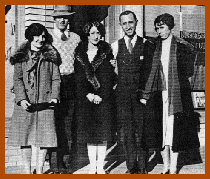 Iwerks was growing tired of the
temperamental Disney, especially as he was doing the majority of the work, and
so was lured by Powers into opening his own studio with an exclusive contract.
Disney desperately searched for someone who could replace Iwerks, as he was not
able to draw as well or as quickly; Iwerks was reported to have drawn up to 700
drawings a day for the first Mickey shorts.
Iwerks was growing tired of the
temperamental Disney, especially as he was doing the majority of the work, and
so was lured by Powers into opening his own studio with an exclusive contract.
Disney desperately searched for someone who could replace Iwerks, as he was not
able to draw as well or as quickly; Iwerks was reported to have drawn up to 700
drawings a day for the first Mickey shorts.
Meanwhile, Iwerks launched his
successful
Flip the Frog series with the first sound cartoon in color,
"Fiddlesticks," filmed in two-strip Technicolor. Iwerks also created two other
series of cartoons, the
Willie Whopper and the
Comicolor cartoon series. Iwerks closed his
studio in 1936 to work on various projects dealing with animation
technology. Iwerks would return to Disney in 1940 and, in the studio's research
and development department, would go on to pioneer a number of film processes
and specialized animation technologies.
Eventually, Disney was able to
find a number of people to replace Iwerks. By 1932, Mickey Mouse had become
quite a popular cartoon character. The
Van Beuren cartoon studio attempted to cash in on this success by creating a
specific process, making these the first commercial films presented in this new
process. The first color Symphony was
Flowers and Trees, which won the first
Academy Award for Best Short Subject: Cartoons in 1932.
First Academy Award
In 1932, Disney received a
special
Academy Award for the creation of Mickey Mouse, whose series was moved into
color in 1935 and soon launched
spin-off series for supporting characters such as
Donald Duck,
Goofy, and
Pluto.
The family grows

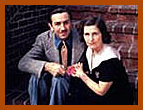

As Mickey's co-creator and
producer, Disney was almost as famous as his mouse cartoon character, but
remained a largely private individual. His greatest hope was to be a father to
many children. However, the Disney's first attempts at pregnancy ended in
miscarriage. This, coupled with pressures at the studio, led to Disney having "a
hell of a breakdown", as he called it. His doctors said that he had to get away
for a while, so he and his wife went on a
Caribbean cruise and then traveled to
Washington, D.C.
When Lilly Disney became pregnant
again, Disney told his sister in a letter that he did not care what gender the
child was, just as long as they were not disappointed again. Lilly finally gave
birth to a daughter,
Diane Marie Disney, on December 18, 1933. Disney was excited to finally have
a child. A few years later the Disney's adopted a second daughter,
Sharon Mae Disney, born on December 21, 1936.
1937-1941: The Golden Age of Animation
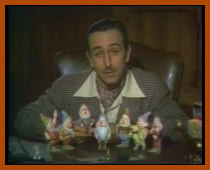
"Disney's Folly": Snow White and the Seven Dwarfs
Disney introduces his popular creations: Mickey, Minnie Mouse
and Pluto to
Hansel and Gretel (Dorothy
Rodin and Virginia Murray).
Although his studio produced the
two most successful cartoon series in the industry, the returns were still
dissatisfying to Disney, and he began plans for a full-length feature in 1934.
When the rest of the film industry learned of Disney's plans to produce an
animated feature-length version of
Snow White, they dubbed the project "Disney's Folly" and were certain that
the project would destroy the Disney studio. Both Lillian and Roy tried to talk
Disney out of the project, but he continued plans for the feature. He employed Chouinard Art Institute professor Don Graham to start a training operation
for the studio staff, and used the Silly Symphonies as a platform for
experiments in realistic human animation, distinctive character animation,
special effects, and the use of specialized processes and apparatus such as the
multiplane camera.
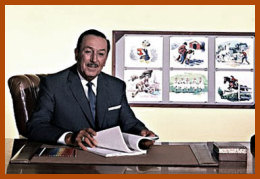 All of this development and
training was used to elevate the quality of the studio so that it would be able
to give the feature the quality Disney desired.
Snow White and the Seven Dwarfs, as the feature was named, was in full
production from 1935 until mid-1937, when the studio ran out of money. To
acquire the funding to complete Snow White, Disney had to show a rough
cut of the motion picture to loan officers at the
Bank of America, who gave the studio the money to finish the picture. The
finished film premiered at the Carthay Circle Theater on December 21, 1937; at
the conclusion of the film the audience gave Snow White and the Seven Dwarfs
a standing ovation. Snow White, the first animated feature in English and
Technicolor, was released in February 1938 under a new distribution deal with
RKO Radio Pictures. The film became the most successful motion picture of
1938 and earned over $8 million (today $98 million) in its original theatrical
release, all the more amazing because children were only charged a dime to see
it. The success of Snow White allowed Disney to build a new campus for
the
Walt Disney Studios in
Burbank, which opened for business on December 24, 1939. The feature
animation staff, having just completed
Pinocchio, continued work on
Fantasia and
Bambi, while the shorts staff continued work on the Mickey Mouse, Donald
Duck, Goofy, and Pluto cartoon series, ending the Silly Symphonies at
this time.
All of this development and
training was used to elevate the quality of the studio so that it would be able
to give the feature the quality Disney desired.
Snow White and the Seven Dwarfs, as the feature was named, was in full
production from 1935 until mid-1937, when the studio ran out of money. To
acquire the funding to complete Snow White, Disney had to show a rough
cut of the motion picture to loan officers at the
Bank of America, who gave the studio the money to finish the picture. The
finished film premiered at the Carthay Circle Theater on December 21, 1937; at
the conclusion of the film the audience gave Snow White and the Seven Dwarfs
a standing ovation. Snow White, the first animated feature in English and
Technicolor, was released in February 1938 under a new distribution deal with
RKO Radio Pictures. The film became the most successful motion picture of
1938 and earned over $8 million (today $98 million) in its original theatrical
release, all the more amazing because children were only charged a dime to see
it. The success of Snow White allowed Disney to build a new campus for
the
Walt Disney Studios in
Burbank, which opened for business on December 24, 1939. The feature
animation staff, having just completed
Pinocchio, continued work on
Fantasia and
Bambi, while the shorts staff continued work on the Mickey Mouse, Donald
Duck, Goofy, and Pluto cartoon series, ending the Silly Symphonies at
this time.
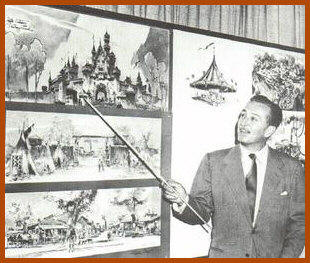 During
making " " Jungle Book" in 1966, Walt Disney died, to the impact of lung cancer.
Employees have been spent extra attention for this reason on the finishing of
that film.
During
making " " Jungle Book" in 1966, Walt Disney died, to the impact of lung cancer.
Employees have been spent extra attention for this reason on the finishing of
that film.
Elias Disney died on 15 December 1966 at 09:30, ten days after its 65th
anniversary. He has been cremated on 17 December 1966 in the Forest Lawn
Cemetery in Glendale, California. Roy Disney finished the Florida project
further, and stood on it, that the name changes in Walt Disney World, for the
honorary of its brother. Roy O. Disney died in 1971, 3 months after the Magic
Kingdom were opened for public.
Also after Walt Disney's dead its studio existence remained and produces still
popular animation and movies.
Some employees of the Walt Disney studios in 1949, a Dixieland has set up
orchestra, which up to in the sixties has made prerecording. This orchestra was
called The Firehouse Five plus Two.
On the animated films of Walt Disney five attraction parks have been based.
Disneyland in Anaheim near at loose Angeles, the Magic Kingdom in the Walt
Disney World Resort in Orlando, Florida, Disneyland Tokyo in Tokyo, Japan and
Disneyland Resort Paris near Paris in France. Disneyland opened its doors in
1955, Walt Disney World Resort followed in 1971, afterwards Tokyo came in 1983,
Paris, in 1992, and Hong Kong in 2005.
